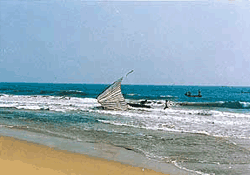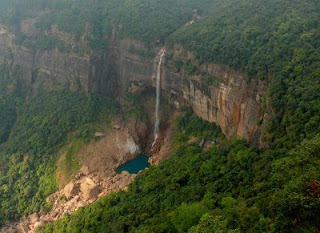|
Reach -
By Air: The Nearest Airport is Bhubaneswar- 65 kms.
By Rail: Well connected to Berhampore (Orissa), Bhubaneswar, Calcutta, Cochin, Delhi, Guwahati, Hyderabad, Madras, Tirupati, Trivandrum, Varanasi.
By Road: Bhubaneshwar- 62 kms, Calcutta- 541 kms, Chilika- 167 kms, Konark- 31 kms, Madras- 1285 kms, Sambalpur- 362 kms, Vishakhapatnam- 486 kms.
Konark
Renowned for its magnificent sun temple, Konark is also a lovely beach resort. In Konark, the  "Natya Mandir", the dance hall of the Sun Temple probably remains as the last remnant of the glorious temples of Orissa an extant example of the architectural excellence of the times. Built in the 13th Century, here a colossal image of the chariot of the Sun, drawn by seven horses and 24 wheels symbolizes the divisions of time. The Konark Sun Temple also houses a Natamandira or dancing hall. Only two subsidiary temples out of the 22 exist today. The Vaishnadevi Mayadevi Temple stand to the West it. The Sun temple of Narasimhadeva is a depiction in stone of the life of those times – royal, social, religious and military. The intricate carvings on the walls and wheels of the chariot are unprecedented in history. "Natya Mandir", the dance hall of the Sun Temple probably remains as the last remnant of the glorious temples of Orissa an extant example of the architectural excellence of the times. Built in the 13th Century, here a colossal image of the chariot of the Sun, drawn by seven horses and 24 wheels symbolizes the divisions of time. The Konark Sun Temple also houses a Natamandira or dancing hall. Only two subsidiary temples out of the 22 exist today. The Vaishnadevi Mayadevi Temple stand to the West it. The Sun temple of Narasimhadeva is a depiction in stone of the life of those times – royal, social, religious and military. The intricate carvings on the walls and wheels of the chariot are unprecedented in history. | The fine sculptures depicting Court life, hunting, scenes, celestial deities are epitomes of precision and grace. Graceful sculptures from the world of the Kamasutra, epic of eroticism also adorn the structures. The Sun Temple standing in solitary splendor is the relic of a great past. y. | |
Area: 2.5 sq km. Altitude: Sea level. Temperature (deg C): Summer- Max. 43, Min. 32.2. Winter- 26.7, Min. 10.6. Rainfall: 152.4 cms (July to September). Clothing: Summer- Light tropical & cottons, Winter- light woolens. Languages spoken: Oriya, Bengali, Hindi, English. Best season: Throughout the year, but preferably October to March. | |
Reach -
By Air: Nearest airport Bhubaneshwar- 64 kms is connected with Calcutta, Delhi, Hyderabad, Madras and Nagpur.
By Rail: Nearest railheads Puri- 31 kms and Bhubaneshwar- 64 kms are connected with the major places.
By Road: Konark is well-connected with Bhubaneshwar as well as the major places. | | 
| |
Chilka Lake | |
Chilika Lake, spreading over an area of 1100 sq. kms is the largest brackish water lake in the country and  attracts large number of migratory birds besides resident ones. Barkul and Rambha are two places on the lake which serve as the base. Though the lake can be visited throughout the year, October to March is the best season. attracts large number of migratory birds besides resident ones. Barkul and Rambha are two places on the lake which serve as the base. Though the lake can be visited throughout the year, October to March is the best season.
Flora:
The lake harbours the "aquatic vegetation" of its own and is typically represents by Algal forms, a number of Diatoms/Phytoplanktons and a few species of brackish water submerged phanerogams like Potamogeton pectinatus, Halophila ovalis etc. The present scanty littoral and scrub jungles on lake margin, islands and rocky faces are represented by the species like Salvadora presica and a number of climbers and herbaceous ground flora. | | The dunes & sandy areas of the beaches near lake have the floral composition of their own, favoured in the conditions they offer. The land lying between Sea and Lagoon exhibits rich growth of casuarinas equisetifolia.
Fauna:
There is a wide variety of animal life forms representing various groups of Animal Kingdom ranging from Protozoa to Mammals. Around 158 species of fishes and prawns have so far been recorded.
Some mammals reported from small pockets in the surrounding hills/forests/scattered islands & amidst the vegetation of sandy ridge facing Chilika and Sea include Black bucks (Antelope cervicara), Spotted deer, Fox, Jackal, Hyena, Jungle Cat, Hare, Rat, Pachyura (an insectivora) etc. | |
Area: 1100 sq. kms. ( Wildlife Sanctuary area- 15.53 sq. kms.) Temperature (deg C): Summer- Max. 37, Min. 30. Winter- Max. 24, Min. 17. Rainfall: 1160 mms. (Mainly July to September). Clothing: Tropical. Languages Spoken: Oriya, Bengali, Hindi, English. Best Season: Throughout the year. | |
Places of Interest:
The lake with several of its islands, main among them being, kalijai, Nalabana, Honeymoon, Breakfast islands etc. Satpada towards the South Eastern stretch of the lake is closer to puri and is fast developing as a tourist spot on the shore of Chilika. | |
Cruise on the lake:
To visit various islands, particularly, Kalijai & Nalabana as well as to cruise on the Chilika Lake, motorised Yatch and speed boat services are available at fixed rates from the Manager, O.T.D.C., Panthniwas, Barkul. | |
Excursions:
Narayani- 22 kms from Rambha, Gopalpur-on-Sea- 45 kms from Rambha and 75 kms from Barkul, Taptapani Sulphur Spring- 100 kms from Rambha and 130 kms from Barkul. | |
Reach -
By Air: Nearest airport Bhubaneshwar is 105 kms from Barkul & 135 kms from Rambha.
By Rail: The nearest railheads are at Balugaon- 7 kms from Barkul and Rambha which are directly connected to Calcutta, Puri, Madras, Hyderabad and Bombay.
By Road: Barkul to Bhubaneshwar- 105 kms, Puri- 167 kms, Cuttack- 133 kms, Berhampur- 78 kms, Gopalpur-on-Sea- 75 kms and Rambha- 30 kms. | | 
| |
Gopalpur | |
Gopalpur-on-Sea is a quiet and charming sea resort along the Bay of Bengal, in the district of Ganjam, Orissa. It  offers secluded environment and magnificent sun, surf and sand for most of the year. offers secluded environment and magnificent sun, surf and sand for most of the year. | |
Altitude: Sea level. Temperature (deg C): Summer- Max. 35, Min. 23. Winter- Max. 27, Min. 16. Rainfall:Languages Spoken: Oriya, Hindi, English. Best Season: Throughout the year, preferably October to April. 118.7 cms (46.7 inches). | |
Places Of Interest:
Gopalpur is situated right on the Bay of Bengal with a beautiful sea-beach. | |
Excursions:
Chilika Lake- 45 kms from Ramba and 75 kms from Barkul, Nirmaljhar- 56 kms, Taptapani (sulphur spring)- 67 kms. | |
Reach -
By Air: Bhubaneshwar is the nearest airport- 180 kms.
By Rail: Berhampur- 16 kms is the nearest railhead.
By Road: Barkul- 75 kms, Berhampur- 16 kms, Bhubaneshwar- 180 kms, Puri- 242 kms. | | 
| |
Simplipal | |
Nestled in the centre of Mayurbhanj, the northernmost district of Orissa is the Similipal National Park one of India's better known wild life sanctuaries, covering a large forested area of 2750 sq.kms. The variation in  topography, climate and vegetation has supported large varieties of animals, birds and reptiles. Similipal is one of the earliest and finest of India's fifteen Tiger reserves under Project Tiger. topography, climate and vegetation has supported large varieties of animals, birds and reptiles. Similipal is one of the earliest and finest of India's fifteen Tiger reserves under Project Tiger. | |
Area: 2750 sq km. Altitude: 559.31 meters above sea level. Temperature (Deg C): Summer- Max.40, Min.20. Winter- Max.20, Min.4.4. Rainfall: 1648 mm ( Mid. June to Mid. September ). Best Season: 1st November to 15th June. December to February is extremely cold. (The reserve remains open from 15th Oct. to 15th June). | |
Places of Interest - Fauna found at the Park include the tiger, leopard, elephants, bison, sambar, porcupine, pangolin, flying-squirrel, hill myna, hornbill, python etc. | |
Excursions - Kiching- 50 kms from Joshipur. | | Reach -
By Air: Nearest airports are Calcutta- 250 kms and Bhubaneshwar- 300 kms.
By Rail: Balasore- 76 kms from Lulung. Jamshedpur- 115 kms from Jashipur.
By Road: Baripada- 20 kms, Jashipur- 114 kms, Bhubaneshwar- 320 kms, Calcutta- 250 kms from Lulung. | | 
| |
Chandipur | |
Chandipur- 16 kms away from Balasore Railway Station on Howrah-Madras line of South Eastern ( S.E.)  Railways annique beach where the sea water recedes about 5 kms during low-tide and advances to the shore line again during high-tides each day. An ideal beach resort of Orissa. Railways annique beach where the sea water recedes about 5 kms during low-tide and advances to the shore line again during high-tides each day. An ideal beach resort of Orissa. | |
Reach -
By Air: The nearest Airport is Bhubaneshwar- 230 kms from Chandipur.
By Rail: The nearest railhead Balasore- 16 kms.
By Road: Balasore- 16 kms, Bhubaneshwar- 230 kms, Cuttack- 230 kms, Calcutta- 240 kms. |
|
 to another influence besides the local one. Meghalaya or the 'abode of the cloud' is meant for Gods to live in with its pure atmosphere. Its sweet water and peaceful environment would attract even Gods. It invites you with open arms to spend some time in its lap of nature. Tucked away in the hills of eastern sub-Himalayas Meghalaya is one of the most beautiful states in
to another influence besides the local one. Meghalaya or the 'abode of the cloud' is meant for Gods to live in with its pure atmosphere. Its sweet water and peaceful environment would attract even Gods. It invites you with open arms to spend some time in its lap of nature. Tucked away in the hills of eastern sub-Himalayas Meghalaya is one of the most beautiful states in  ideal holiday resort throughout the year. Cherrapunjee, the wettest place on earth is only 56 kms away from Shillong. Shad Sukmynsiem means dance with joyful heart. It is a thanks giving dance, held in shillong in the month of April every year.
ideal holiday resort throughout the year. Cherrapunjee, the wettest place on earth is only 56 kms away from Shillong. Shad Sukmynsiem means dance with joyful heart. It is a thanks giving dance, held in shillong in the month of April every year.


















